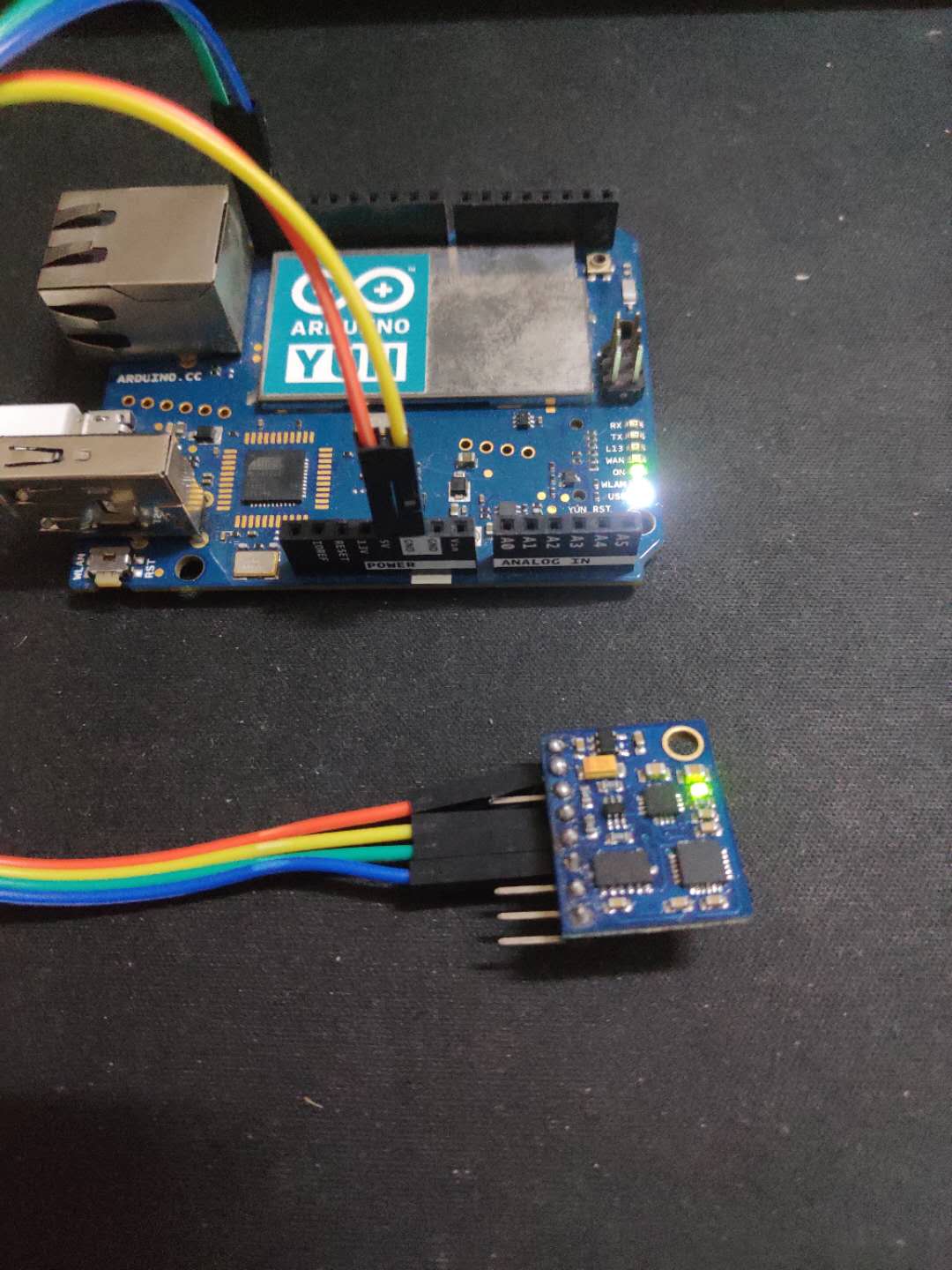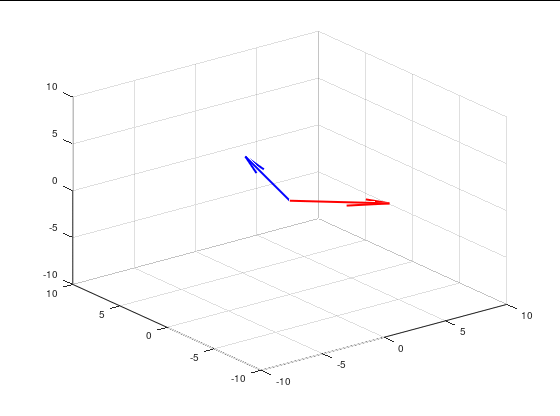Lous Blog
Octave Arduino GY-85 姿态估计
19 Jun 2019Arduino 通过 IIC 总线获取到 GY-85的传感器数据,再通过串口与Octave通讯发送数据。Octave 获取到原始数据并融合估计当前的姿态。

GY-85
一款低精度的9DOF传感器,包含三个芯片:加速度计、磁力计、陀螺仪。其中陀螺仪包含了当前的温度,可用来做校正。故一共可以获采集到当前的3X加速度、3X角速度、3X磁通量、1X温度,共10路信号。
Arduino
通过I2C总线获取传感器数据并通过串口发送给上位机PC。
#include "GY_85.h"
#include <Wire.h>
GY_85 GY85; //create the object
void setup()
{
Wire.begin();
delay(10);
Serial.begin(115200);
delay(10);
GY85.init();
delay(10);
}
void loop()
{
static uint8_t gy85_buff[6 + 6 + 8];
//x-y-z axis[0]=10 axis[1]=32 axis[2]=54
GY85.read_acclerometer_raw(gy85_buff);
//x-y-z axis[0]=01 axis[1]=45 axis[2]=34
GY85.read_compass_raw(gy85_buff + 6);
//x-y-z-temp axis[0]=45 axis[1]=23 axis=[2]=67 axis[4]=01
GY85.read_gyro_raw(gy85_buff + 6 + 6);
//acc x y z [1,0] [3,2] [5,4]
//compass x y z [6,7] [10,11] [8,9]
//gyro x y z t [16,17] [14,15] [18,19] [12,13]
if (Serial.availableForWrite() > 20)
{
Serial.write(gy85_buff, 20);
}
}
Octave Serial
上位机PC上Octave通过串口获取到Arduino发送的数据,解析并完成校正。(后续后考虑把数据校正直接放在Arduino内完成)
数据采集
function [acc_data,gyro_data,compass_data] = gy85_sample(sample_num)
%sample_num 采样次数
pkg load instrument-control
%%if (exist("serial") == 3)
%% disp("Serial: Supported")
%%else
%% disp("Serial: Unsupported")
%%endif
s1 = serial("COM5", 115200,10);
srl_flush(s1);
pause_time=0.005;%发送后等待再读取数据
acc=zeros(1,3);
compass=zeros(1,3);
gyro=zeros(1,4);
%temporature=gyro(4);% 35+( raw + 13200 ) / 280
%% 绕各轴旋转 校正加速度传感器
for i=1:sample_num
%%srl_write(s1, "refresh");
%% 等待arduino 返回数据
%%pause(pause_time)
[uint8_data,count] = srl_read(s1,20);
if(count<20)
disp("count<20 lost data")
endif
raw_data(i,:)=uint8_data;
end
for i=1:sample_num
%% 按指定格式解析数据
uint8_data=raw_data(i,:);
[acc,compass,gyro]=parse_data(uint8_data);
acc_data(i,:)=acc;
gyro_data(i,:)=gyro;
compass_data(i,:)=compass;
end
fclose(s1) % Closes and releases serial interface object
endfunction
数据解析
解析数据协议需要和Arduino一致
function [acc, compass, gyro] = parse_data(uint8_data)
% raw data present in the order below
%acc-x y z [1,0] [3,2] [5,4]
%compass x y z [6,7] [10,11] [8,9]
%gyro x y z t [16,17] [14,15] [18,19] [12,13]
data = double(uint8_data);
%% acc data
acc(1) = data(2) * 256 + data(1);
acc(2) = data(4) * 256 + data(3);
acc(3) = data(6) * 256 + data(5);
%% compass data
compass(1) = data(7) * 256 + data(8);
compass(2) = data(11) * 256 + data(12);
compass(3) = data(9) * 256 + data(10);
%% gyro data
gyro(1) = data(17) * 256 + data(18);
gyro(2) = data(15) * 256 + data(16);
gyro(3) = data(19) * 256 + data(20);
gyro(4) = data(13) * 255 + data(14);
% convert to the number that matlab can compute
acc = acc .* (acc < 2^15) - (2^16 + 1 - acc) .* (acc >= 2^15);
compass = compass .* (compass < 2^15) - (2^16 + 1 - compass) .* (compass >= 2^15);
gyro = gyro .* (gyro < 2^15) - (2^16 + 1 - gyro) .* (gyro >= 2^15);
endfunction
计算姿态并作图
不做滤波和数据融合
function imu_real_time()
title('Acc-Red Mag-Blue')
filename='GY-85 Acc Mag.gif';
for i = 1:10
[acc_data, gyro_data, compass_data] = gy85_sample(1);
% g=9.8;
% acc factor and offset
acc_offset = [5.6804; 13.827; 5.8449; 12.519; 0.46976; 14.399];
offset = [acc_offset(1), acc_offset(3), acc_offset(5)];
scale = [acc_offset(2), acc_offset(4), -acc_offset(6)];
% calibration acc data
acc_uvw = (acc_data - offset) ./ scale;
% normalization compass vector
compass_uvw = 5 * compass_data / norm(compass_data);
% current positon
pos = [0, 0, 0];
plot_uvw(pos, [acc_uvw; compass_uvw]);
% save image as gif
drawnow;
frame = getframe(1);
im = frame2im(frame);
[imind,cm] = rgb2ind(im);
if i == 1;
imwrite(imind,cm,filename,'gif', 'Loopcount',inf,'DelayTime',1);
else
imwrite(imind,cm,filename,'gif','WriteMode','append','DelayTime',1);
end
pause(0.05)
end
endfunction
红色-加速度方向
蓝色-磁力计方向

传感器融合
静态磁力计所计算出来地磁场方向是相对准确的。
静态加速度传感器所计算出来的重力方向也是相对准确的。
因为地磁场方向和重力方向在环境未发生变化的是整体是不会发生变化的,所以静态我们根据磁力计和加速度计就可以估算出当前传感器的三维姿态。
当前时刻加速度计测得$\overrightarrow{a_k}$